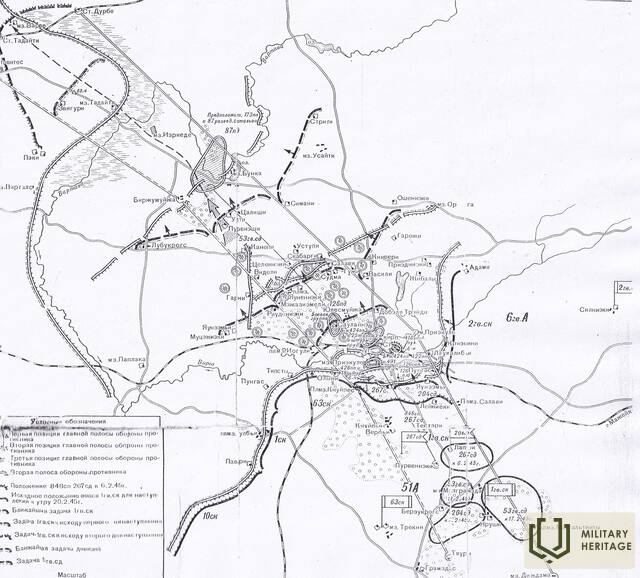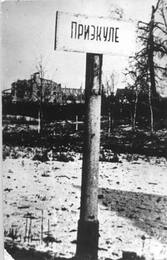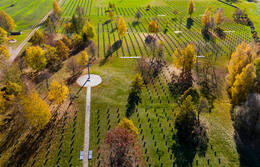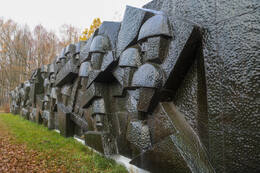Priekulės operacija II WW2
1945 m. vasario 20 d. per Penktąjį Didįjį Kuršo mūšį (1945 m. vasario 12 d. – kovo 14 d.) Raudonoji armija pradėjo puolimą Liepojos kryptimi 30 km pločio ruože abipus Priekulės.
Įnirtingose kovose, trukusiose iki kovo 1 d., Raudonajai armijai pavyko 1-2 km atstumti vokiečių linijas ir užimti Priekulę. Kovo 5 d. prasidėjo puolimas į pietus nuo Saldus, kuriame dalyvavo 8 Raudonosios armijos pėstininkų divizijos ir 2 tankų daliniai. Čia Raudonajai armijai pavyko giliau įsiveržti į vokiečių pozicijas į rytus nuo Saldus ir vietomis pasiekti Saldus-Liepoja plentą.
Kovo 14 d. sovietų puolimas sušvelnėjo. Raudonoji armija prarado 70 000 žuvusių ir sužeistų kareivių, 608 tankus ir 178 lėktuvus, bet įgijo nedidelį plotą, įskaitant Džūkstę ir Priekulius.
Susijusios vietos
Saldaus vokiečių kareivių kapinės
Saldaus vokiečių kareivių kapinės yra prie Saldaus–Ežerės plento. Kapinėse, užimančiose 8 hektarų plotą, yra apie 25 000 vokiečių kareivių, taip pat kai kurių Latvijos legionierių palaikai. Perlaidojimai vyksta nuo 1997 m.
Nuo gegužės 1 d. iki spalio 1 d. memorialiniame kambaryje galima apžiūrėti parodą apie Kuršo mūšius. Šiuo laikotarpiu memorialinis kambarys dirba darbo dienomis nuo 9:00 iki 17:00 val., o šeštadieniais ir sekmadieniais kapinėse dirba ir gidas. Taip pat galima susipažinti su Saldaus vokiečių kareivių kapinėse palaidotų ir visoje Latvijoje žuvusių kareivių sąrašais.
Priekulės karių kapinių memorialinis ansamblis
Priekulės karių kapinių memorialinis ansamblis yra Liepojos-Priekulės-Skodos kelyje ir yra didžiausia Antrojo pasaulinio karo sovietų karių laidojimo vieta Baltijos šalyse. Čia palaidota daugiau nei 23 000 sovietų karių. Operacija „Priekulė“ buvo vienas įnirtingiausių mūšių Kuržemės tvirtovėje, vykęs nuo 1944 m. spalio iki 1945 m. vasario 21 d. Priekulės mūšis 1945 m. vasarį truko septynias dienas ir naktis be perstojo ir pareikalavo daug aukų abiejose pusėse. Iki Priekulės karių kapinių pavertimo memorialu čia buvo pastatytas paskutinis iškilaus latvių skulptoriaus K. Zālės (1888–1942) paminklas, skirtas Alojos nepriklausomybės kovoms atminti. Nuo 1974 iki 1984 m. 8 ha Priekulės karių kapinės buvo paverstos memorialiniu ansambliu, skirtu Antrojo pasaulinio karo žuvusiems. Jį suprojektavo skulptorius P. Zaļkalne, architektai A. Zoldners ir E. Salguss bei dendrologas A. Lasis.
Memorialo centre stovi 12 m aukščio statula, vadinama „Tėvyne“, o žuvusiųjų vardai iškalti granito plokštėse. Iki Latvijos nepriklausomybės atgavimo Pergalės diena buvo plačiai švenčiama kasmet gegužės 9 d.
Susijusi istorija
„Karas nesibaigia, kol nebus palaidotas paskutinis karys“ (Priekulės brolių kapinės)
1944 m. spalio 10 d. Kurša iškilo kaip atskiras ir savitas mūšio laukas. Buvo laikoma, kad apie 500 000 vokiečių karių buvo apsupti. Remiantis 1-ojo Baltijos fronto štabo pranešimais, norint visiškai išlaisvinti visą Baltijos pakrantę, prireikė tik „nedidelių pastangų“. Tačiau kovos Kuršoje tęsėsi dar septynis mėnesius ir Kurša tapo Antrojo pasaulinio karo pabaigos simboliu.
Per septynis mūšio mėnesius iki 1945 m. gegužės Vokietijos ginkluotosios pajėgos Kuržemėje neteko 154 108 žuvusių, sužeistų ir dingusių be žinios karių, o Raudonosios armijos nuostoliai buvo apie 400 000 žuvusių, sužeistų arba dingusių be žinios.








